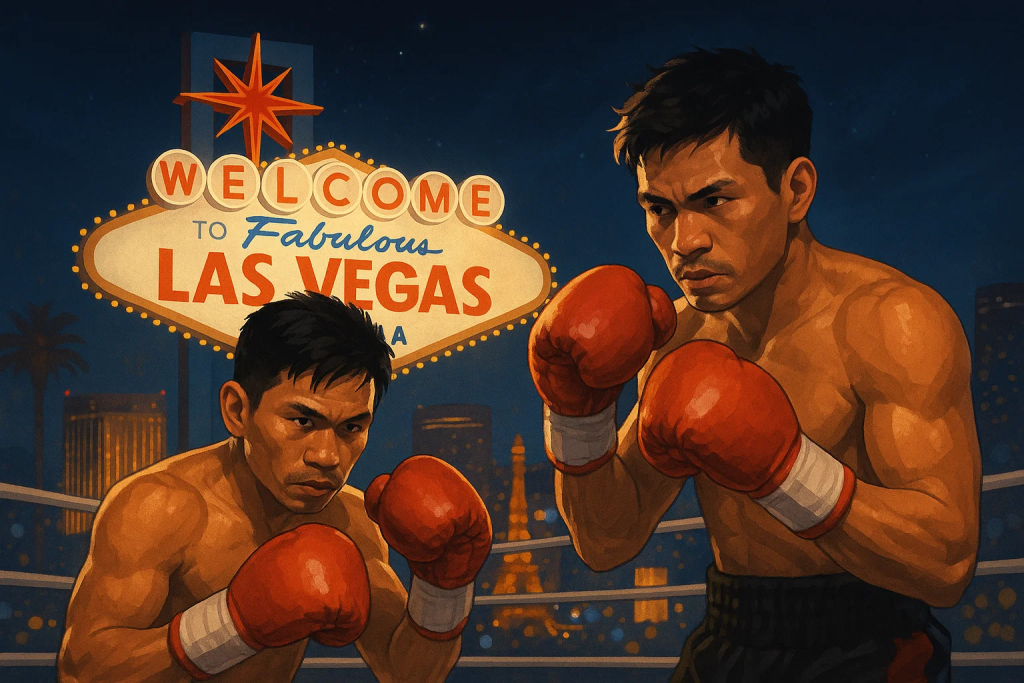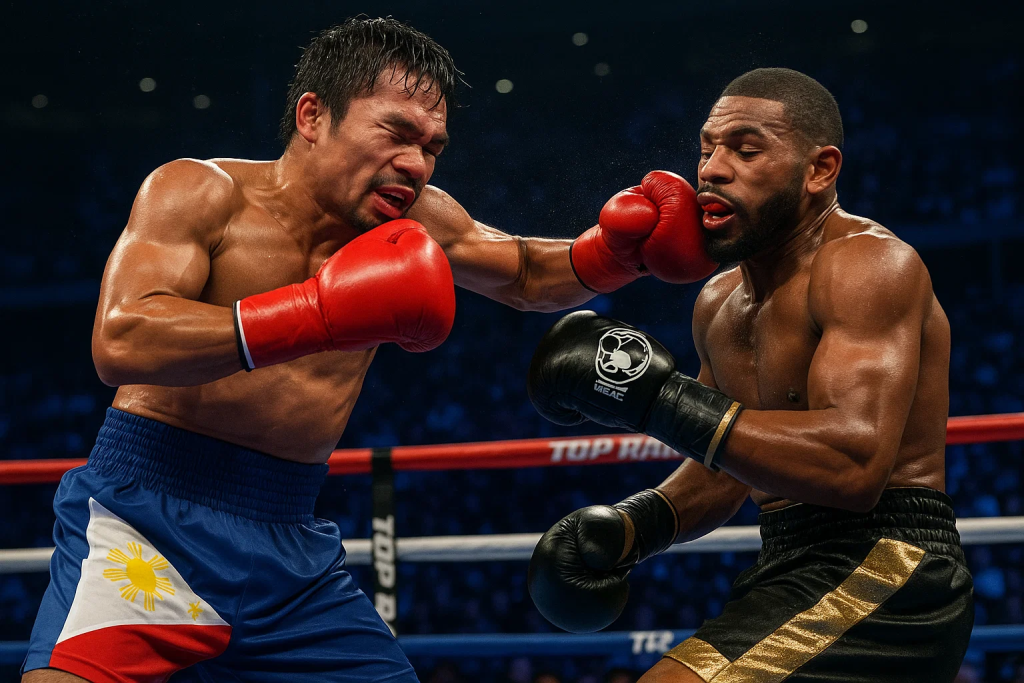Table of Contents
From Cebu to the Strip—why the next Pinoy surge is arriving now
This long-form preview breaks down how Filipino contenders can convert Vegas opportunities into career momentum—from training camps and styles that sell, to matchmaking, brand building, and what fans should watch for. We’ll keep the focus on repeatable frameworks that help prospects, coaches, and supporters understand the blueprint for success—while giving casual readers a clear, hype-free crash course in Pinoy boxing 2.0.
For more than a century, Filipino fighters have punched above their weight—bringing relentless pace, iron wills, and improbable storylines to boxing’s biggest stages. Today, a new wave of Pinoy boxers is shaping up for Las Vegas, the sport’s most influential spotlight. This isn’t just nostalgia. The ecosystem has matured: better strength-and-conditioning programs at home, smarter management and nutrition, social media savvy, and diaspora crowds that turn any fight week into a home game.

Why Vegas still matters (and always will)
Ask any manager or trainer: Las Vegas concentrates what matters most in the boxing economy.
- Visibility: Networks, promoters, matchmakers, and media are clustered around fight weeks on the Strip. One explosive performance can snowball into bigger purses and TV undercards.
- Meritocracy under lights: Vegas cards attract opponents with real resumes. A breakout win here travels globally in highlight reels and ratings.
- Fan power: Filipino communities across the U.S. show up—families, nurses coming off shift, hospitality crews—creating an atmosphere that lifts fighters and persuades promoters to book the next Pinoy slot.
- Sponsor magnet: Hospitality, travel, and Filipino-owned brands find natural activation windows around fight week pop-ups, viewing parties, and meet-and-greets.
Bottom line: Vegas compresses opportunity. It’s the best place to prove you’re not just a regional phenom—but a TV-reliable, internationally bankable fighter.
The Filipino style, updated: pressure, poise, precision
If you’ve followed Pinoy boxing for years, you know the stereotypes—relentless aggression, southpaw chaos, and dogged body work. The next wave refines those strengths with more shot selection, defensive layers, and ring craft.
What separates modern Pinoy prospects:
- Educated pressure
- Cutting the ring with half-steps instead of wild chases.
- Using feints to create tells before launching the left cross or right straight.
- Body investment, smarter timing
- Double-touch jabs upstairs to disguise the left hook to liver.
- Finishing combinations with a shoulder nudge to reset angles—legal, subtle, effective.
- Counter-punching in the pocket
- Catch-and-shoot sequences: parry the jab, return with a quick 2–3.
- Slip to the outside and feed the overhand left; pivot off before the clinch.
- Defense first, offense always ready
- High guard morphing into a “peek-a-boo” shell for infighting.
- Better head position and foot placement to avoid head-butts and cuts.
- Gas tank management
- Rounds 7–10 often decide prospects’ futures; next-gen camps program tempo ladders to keep power late.
Translation for fans: expect less brawl, more control—without losing the Pinoy love for clean, fight-ending offense.
The pipeline: from barangay gyms to big-room nights
The modern Filipino boxing journey is no longer a leap of faith. It’s a ladder.
- Foundation (ages 12–16)
- Multi-sport footwork (basketball, track) plus basic mitts and inter-club bouts.
- Early conditioning that emphasizes mobility and injury prevention over macho mileage.
- Regional & national circuits (16–20)
- Amateur tournaments to harden pacing, judging dynamics, and nerves.
- Nutrition 101 (hydration, sodium/potassium balance), early anti-cutting education.
- Developmental pro fights (18–24)
- 4-rounders to 8-rounders against durable foils; learning to win on scorecards when the KO doesn’t come.
- Sparring exchanges with foreign stables visiting the Philippines.
- U.S. camp fly-ins (20–26)
- Rotations between West Coast and Las Vegas gyms for sparring diversity.
- Test fights on U.S. undercards; adapt to commission standards, rehydration rules, and media day pressures.
- Breakout stage (22–28)
- Matchmaking steps up: undefeated prospects, former world title challengers, TV swing bouts.
- If the style plays on camera—and the fighter closes—Vegas becomes home base.
The five archetypes of Pinoy prospects who play well in Las Vegas
- The Pressure Southpaw
- Right-hand lead probes, lefty power, and craft in mid-range.
- Crowd-pleasing because exchanges are frequent, but defense keeps it clean.
- The Compact Counter-Puncher
- Quick eyes, disciplined glove returns, and no wasted motion.
- Wins respect with short, snappy counters that replay well on broadcast.
- The Rangy Jab-and-Move Stylist
- Longer frame for the weight; wins rounds by first contact and exit angles.
- Upside comes when he layers in a sneaky back-hand to stop chasers.
- The Inside Mechanic
- Body-head sequencing, uppercut awareness, and clinch literacy.
- Referees in Vegas reward fighters who work free instead of stalling.
- The Volume Engine
- Throws in bunches, but with punch economy (2–4 shot clusters).
- Judges love consistent initiative; commentary teams love the pace.
Camp design: the science behind the swing
Boxing is still a hurt business—but preparation has modernized. The next wave of Filipino fighters builds repeatable systems around four lanes:
A) Strength & conditioning
- Periodized sprint work for fight-week power, not just road-work miles.
- Rotational core training (med-ball throws, landmine presses) for punch transfer.
- Hip-ankle mobility to keep power while preventing late-camp tweaks.
B) Technical scripts
- “Win the first minute” drills (jab math, space-owns-time).
- Ropes and ladders for rhythm; mitts emphasize punch-then-position (hit, step, fold).
C) Sparring with intent
- Early camp “volume rounds,” middle “chaos rounds,” late “solutions rounds.”
- Film the last two spars only—avoid over-critiquing early rust.
D) Recovery & weight management
- Daily HRV checks, sleep targets, and strategic cold/heat exposure.
- Protein targets based on lean mass; final two weeks prioritize glycogen without bloat.

Matchmaking 101: when to swing big, when to bank rounds
The Vegas runway rewards smart sequencing.
- Bank the résumé: Beat a well-traveled opponent who’s taken prospects the distance. Learn how judges read control.
- Style test: Take a different look—a switch-hitter, a spoiler, or a tall counter-jabber. Solve the puzzle under lights.
- Momentum swing: Once you’ve checked those boxes, take the live TV step-up. If the dance partner is aggressive, that’s a TV-friendly style clash for a breakout.
Green flags for a step-up fight:
- Two or three camps in a row with injury-free sparring.
- Down-the-stretch stamina proven in 8–10 rounds.
- Weight cut consistent—not a dramatic water drop that kills legs.
The business of being watchable: media, brand, diaspora
Even in a meritocracy like boxing, perception multiplies performance.
Media fundamentals that work for Pinoy fighters:
- Narrative clarity: 2–3 talking points (“nurse’s son,” “OFW roots,” “STEM student turned boxer”) that commentators can repeat.
- Content cadence: 2 short clips/week during off-camp; 3–4/week in camp (mitts, bag, roadwork, family, food).
- Diaspora activation: Coordinate with Filipino communities for watch parties, flag merch, and prayer breakfasts. Feels authentic, converts casuals into repeat buyers.
Sponsor alignment:
- Filipino restaurants, healthcare services, travel agencies, and OFW-focused brands naturally fit; co-create fight-week events and charity tie-ins.
- Deliver scan-to-store numbers post-fight (QR redemptions, RSVPs). That data keeps partners invested.
What fans should watch for on fight night
- The first minute: Does the fighter claim center ring or circle to decode patterns?
- Body-head balance: Are body shots softening the guard for later head attacks?
- Cut & corner work: Pinoy corners are famously calm—watch the adjustments from Rounds 4–6.
- Engine check late: Do punches retain snap at minute 30? If yes, the camp got the taper right.
- Composure after getting clipped: Vegas audiences appreciate recovery IQ as much as chin.
Why the next Pinoy wave is built to last
Three forces make this surge sustainable:
- Better inputs at home
- More S&C literacy, more nutrition coaches, better sparring networks.
- Smarter opponent selection
- Teams increasingly accept “boring” developmental fights to fix weaknesses before TV steps.
- Community capital
- Filipino fans fill arenas, but also share content in family networks—turning big moments into multi-week tailwinds for a fighter’s name recognition.
A sample blueprint: 12 months to a Vegas breakthrough (non-fighter specific)
Quarter 1
- Two 8-rounders vs. winning records; prove cardio and cut resistance.
- Media: origin mini-doc, local gym community day, simple newsletter signup.
Quarter 2
- U.S. fly-in sparring block; one stateside undercard against a spoiler.
- Media: content collab with a Filipino restaurant or brand; release training playlist.
Quarter 3
- Step-up vs. fringe contender; 10-round distance with late surge or stoppage.
- Media: open workout, diaspora meet-and-greet, sponsor sampling.
Quarter 4
- Vegas swing bout opposite an aggressive style.
- Post-fight: highlight reel, charity visit, data recap for sponsors (QR redemptions, social reach, ticket code usage).
For coaches and managers: common pitfalls to avoid
- Weight-cut heroics: Last-minute water dumps ruin legs. Schedule the taper.
- Endless wars in sparring: Save the hardest rounds for the middle of camp, not fight week.
- Narrative clutter: Too many storylines confuse broadcasters. Pick two and hammer them.
- Over-booking: Back-to-back cuts and bruises cost more than a canceled date. Live to fight the bigger fight.
For casual fans: how to support Pinoy fighters (beyond posting)
- Buy the stream or ticket, not just clips—purchase metrics move promoters.
- Leave ratings for partner restaurants and Filipino businesses that sponsor fighters.
- Share KO highlights with context (opponent, stakes, round). Your aunt will forward it to five more titas, trust us.
- Be respectful online. Fighters and families read comments—lift them up.

What’s next: divisions to watch, styles that will trend
- Lower weights (112–122): Speed, volume, and crowd-pleasing exchanges—prime TV real estate for Filipino technique.
- 130–135: Southpaw chaos vs. rangy jabbers; Vegas loves chess with sudden violence.
- Body-first game plans will trend as opponents guard high against Pinoy straight lefts and right crosses; liver shots and shovel hooks will decide co-mains.
Join the next chapter of Pinoy boxing
If you’re a fan, tell us which weight class you’re most excited about—and the last Pinoy fight that made you jump off the couch.
If you’re a gym owner or brand, share your city and what kind of fight-week activation you could host (watch party, fan run, tasting).
If you’re a fighter/coach, drop your camp dates and one skill you’re sharpening; we’ll compile a neutral resource list of sparring contacts, nutrition checklists, and media templates you can adapt.
Together, we can help the next wave of Filipino fighters turn Vegas chances into Pinoy knockouts that travel the world.
From barangay rings to big-room lights, the blueprint is clear: train smart, choose smart, finish strong—and let a supportive community amplify every punch. The next chapter of Pinoy knockouts in Vegas is already being written.
FAQs: Pinoy Knockouts in Vegas
1) Bakit target ng mga Pinoy ang Las Vegas?
Las Vegas concentrates promoters, networks, and high-visibility cards. Isang malaking panalo rito ay mas madaling magbukas ng mas malalaking undercards, mas mataas na purses, at sponsor interest—samantalang supportive ang diaspora crowd.
2) Anong estilo ang pinakamadaling mag-translate sa Vegas undercards?
Educated pressure + body investment + counter-punching sa mid-range. Crowd-pleasing ang exchanges pero kontrolado at TV-friendly; judges at commentators kitang-kita ang ring craft.
3) Paano naghahanda ang next-gen Pinoy boxers physically?
Periodized S&C (sprint at rotational power), technical scripts (punch-then-position), intentional sparring blocks (volume → chaos → solutions), at maayos na weight management (glycogen without bloat, sleep targets, HRV checks).
4) Ano ang role ng Filipino community sa U.S.?
Sila ang “home crowd” sa abroad: nagbu-book ng tickets, nag-o-organize ng watch parties, at tumutulong sa brand activations. Ang word-of-mouth ng pamilya/komunidad ay tumatagal lampas fight week.
5) Kung baguhan ako, saan ako magsisimula manood?
Hanapin ang undercards ng major Vegas weekends—marami ang featuring Filipino prospects. Panoorin ang first minute (control), mid-round body work (setup), at late-round composure (closing). Kapag kumpleto ang tatlong iyon, may panibagong Pinoy contender na paparating.
